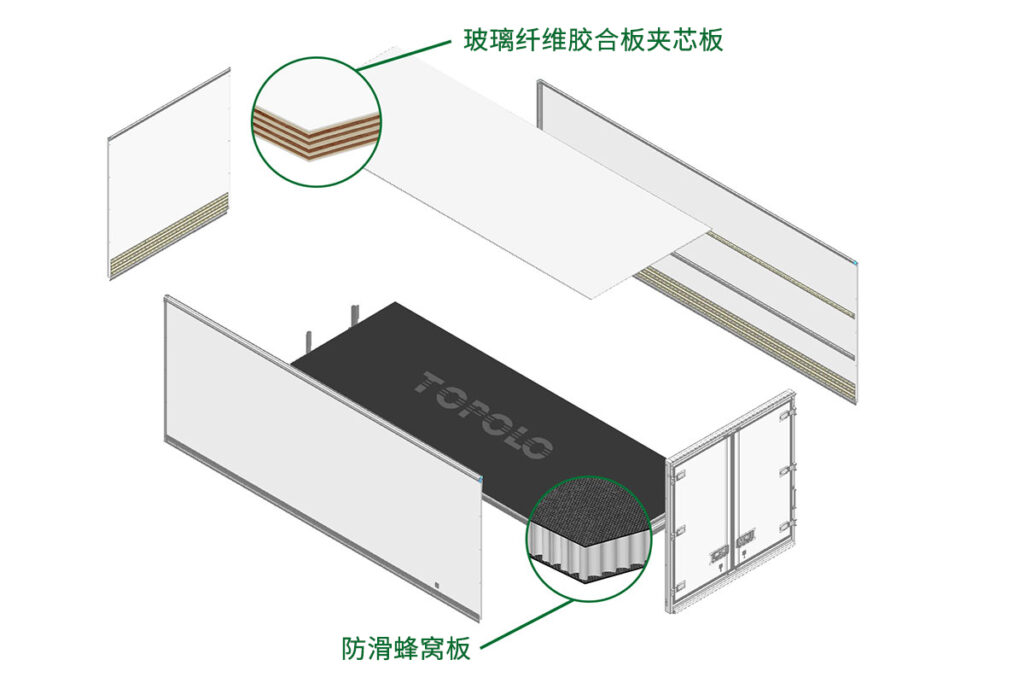Home » Box Truck Bodies » Dry Freight Truck Bodies

胶合板是一种广泛使用的可再生材料,玻璃纤维胶合板夹芯板是希望制造高性能、耐用且具有成本效益的干式卡车车身的制造商的绝佳选择。它们的尺寸、厚度和绝缘选项可以定制,以满足不同运输任务的特定需求。玻璃纤维胶合板夹芯板为干货卡车车身提供了理想的解决方案,将胶合板的强度和耐用性与玻璃纤维的轻质和耐腐蚀特性相结合。这些面板旨在满足严格的运输要求,提供出色的结构完整性,同时保持卡车车身的整体重量较低。

规格
| 面临 | 热固性玻璃钢——玻璃纤维增强塑料。 热塑性玻璃钢 (CFRT) – 连续纤维增强热塑性塑料。 |
| 核心 | 船用胶合板。(桦木、松树、杨树、桉树、橡树等) |
| 厚度 | 10-50mm. |
| 长度 | ≤12000mm. |
| 宽度 | ≤3200mm. |
船用胶合板 – 耐用、防水的材料
船用胶合板是一种优质的高性能材料,因其耐用性、强度和防潮性而常用于干货卡车车身。它经过专门设计,可承受恶劣的环境,非常适合在不同的天气条件下运输货物。通过在卡车车身制造中使用船用胶合板,制造商可以为干货运输创造持久可靠的解决方案。
防潮性
船用胶合板经过防水处理,非常适合暴露在潮湿环境中的环境。这对于可能遇到潮湿环境的干式卡车尤其有利。
强度和耐用性
船用胶合板具有多层单板,可提供出色的强度,确保卡车车身能够承受日常使用的严酷考验,同时承载重物,而不会随着时间的推移而翘曲或变质。
耐腐蚀性能
与传统的木材或金属不同,船用胶合板能够抵抗暴露在潮湿环境中的腐蚀,使其成为卡车车身结构的低维护选择。

热固性玻璃钢与热塑性玻璃钢
| 特征 | 热固性玻璃钢 | 热塑性玻璃钢 (CFRT) |
|---|---|---|
| 材料属性 | 坚固、坚硬、耐热、耐化学腐蚀。 | 柔韧,加热后可重塑。 |
| 耐温性 | 更高的耐热性和耐热降解性。 | 与热固性玻璃钢相比,耐热性更低。 |
| 耐久性 | 在高应力条件下的长期性能方面较不耐用。 | 在极端条件和高压力下更耐用。 |
| 可回收性 | 一旦凝固就不能重熔或重塑,难以回收。 | 可复热重塑,更可回收。 |
| 成本 | 由于生产过程复杂,通常更昂贵。 | 更具成本效益,特别是对于大规模制造。 |



如何加工胶合板夹芯板
依靠智能数控加工,胶合板夹芯板快速准确地加工成设计的形状和尺寸。面板的每一个细节都得到了完美的呈现。无论是复杂的切割、冲孔还是边缘加工,智能加工设备都能确保加工精度。
如何连接胶合板夹芯板
使用金属型材和铆钉,可以牢固地连接地板、墙板和车顶板,并快速组装成干车车身。这种模块化的组装方式大大缩短了生产时间,降低了人工成本,使车身的各个部位在结构上更加稳定可靠。金属型材的强度保证了连接的牢固性,而铆钉的使用使得组装过程变得简单快捷,大大提高了工作效率。最后,精密组装的车身性能也得到了保证,具有出色的耐用性、抗震性和抗风压性。

要了解有关干货卡车车身复合板应用的更多信息,请联系我们。